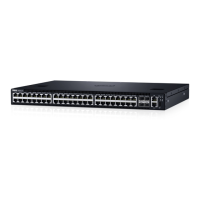vrrp bfd neighbor ip-address interval milliseconds min_rx milliseconds multiplier value role
[active | passive]
To view session parameters, use the show bfd neighbors detail command, as shown in the example in Verifying BFD Sessions
with BGP Neighbors Using the show bfd neighbors command example in Displaying BFD for BGP Information.
Disabling BFD for VRRP
If you disable any or all VRRP sessions, the sessions are torn down.
A nal Admin Down control packet is sent to all neighbors and sessions on the remote system change to the Down state.
To disable all VRRP sessions on an interface, sessions for a particular VRRP group, or for a particular VRRP session on an interface, use the
following commands.
• Disable all VRRP sessions on an interface.
INTERFACE mode
no vrrp bfd all-neighbors
• Disable all VRRP sessions in a VRRP group.
VRRP mode
bfd disable
• Disable a particular VRRP session on an interface.
INTERFACE mode
no vrrp bfd neighbor ip-address
Conguring Protocol Liveness
Protocol liveness is a feature that noties the BFD manager when a client protocol is disabled.
When you disable a client, all BFD sessions for that protocol are torn down. Neighbors on the remote system receive an Admin Down
control packet and are placed in the Down state.
To enable protocol liveness, use the following command.
• Enable Protocol Liveness.
CONFIGURATION mode
bfd protocol-liveness
Troubleshooting BFD
To troubleshoot BFD, use the following commands and examples.
To control packet eld values or to examine the control packets in hexadecimal format, use the following command.
• Examine control packet eld values.
CONFIGURATION mode
debug bfd detail
• Examine the control packets in hexadecimal format.
CONFIGURATION
debug bfd packet
Bidirectional Forwarding Detection (BFD)
165

